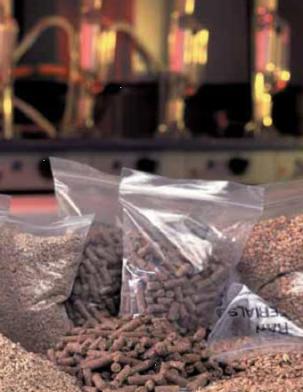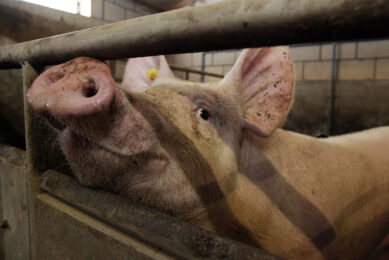Pathogen control crucial for feed producers

Ever more stringent legislation to improve food safety will continue to place increasing demands on feed manufacturers and their customers. The industry therefore needs novel, cost-effective solutions to meet these new challenges.
Food safety is a growing issue, not only in the European Union but throughout the world, and concurrent with new EU legislation focusing on this area a number of critical factors are converging. Globally, dietary patterns are changing, incidences of food safety and public health issues are increasing, consumers are becoming more aware of what they eat and how it is produced, while retailers are making ever-more-stringent demands on suppliers. All these factors are increasing the pressure on feed manufacturers, requiring them to focus more intently on achieving higher standards of pathogen control to reduce the possibility of contamination in their products.
Significant losses
While mould and bacterial contamination of feed and feed ingredients can cause significant productivity losses in poultry, livestock and fish, bacterium such as Salmonella cause illness, even death, in susceptible humans who consume contaminated animal products such as eggs, meat and milk. The variables which combine to compound the problems caused by this robust, persistent organism include environmental contamination, susceptible animals and the fact that farmers, despite being aware of the issue, have not really been motivated to deal with it due to the direct cost implications on their businesses and lack of any positive financial incentive. However, with more legislation on the way, this is an issue which they will have to address.
Salmonella has an affinity for pig farms and pigs, reaching the stomach almost immediately after being ingested, in most cases through faecal contamination of the pen by other infected animals. The problem is often due to, or exacerbated by, economic issues. Long-term pressures on profit margins have meant that many pig farms have underinvested over the years and use old buildings which are difficult to clean, chronically contaminated and provide a perfect habitat for vermin. Couple that with poor standards of hygiene, disinfection and bio-security, plus the stress on animals caused by mixing, transporting and over-stocking and you’ve a breeding ground for trouble.
Whilst Salmonella cannot be entirely eradicated, it can be controlled. For example, how pigs are fed and what they are fed can have a big effect. A number of factors are associated with high levels of Salmonella in pigs, including pelleted and heat-treated feed, small particle size, feeding twice daily or less and sudden changes in diet. On the other hand, factors which help to reduce levels include low feed pH, liquid feed, liquid whey products, organic acids, coarsely ground meal (4-6mm), 25% + high-fibre grain, low acid binding capacity, frequent, smaller meals or ad-lib feeding and gradual feed changes.
Control struggle
In the poultry sector, pathogen control measures have already led to the implementation of high standards in an industry which puts tremendous effort and resources into minimising the risk of infection. For example, 95% of layer producers vaccinate their flocks and breeder feedingstuffs delivered in bulk for layer, broiler, duck or turkey parent/grandparent stock are subjected to a Salmonella kill step by heat treatment or other validated method, unless the customer specifies otherwise, in writing.
Salmonella in pigs has, however, long been a problem. The EFSA Report published in June 2008 highlighted a wide variation in standards, with levels of Salmonella infection found in the lymph nodes of slaughtered pigs ranging from 0% in Sweden and Finland – countries which have a zero-tolerance policy and slaughter out positive animals – to 24.8% in Greece. Levels found on carcasses ranged from 0% in Sweden and Slovenia to 20% in Ireland. Clearly, many countries have struggled to control Salmonella yet in others, such as Denmark and The Netherlands which have invested in modern facilities and use more slatted flooring, there is a low prevalence. Denmark, for example, has the most advanced programme, estimated to cost €0.20 per pig, with a strict penalty system in place. Antibody levels in breeding pigs and multipliers are monitored monthly, slaughter pigs are checked continuously using meat juice ELISA and a Salmonella index is calculated on the last three months data.
In addition, faecal samples are tested from level 2 and 3 herds, the supply chain checked, level 3 herds are slaughtered and meat treated, while feed compounders heat treat all feed as a routine. The result is that Salmonella declined from 3%-4% in 1993 to 0.7% in 1995 and the level is now almost static. In many countries the presence of Salmonella continues to cause significant economic loss to producers through reduced feed intake, lower daily liveweight gain and feed conversion, together with increased management and veterinary costs. The problem is multi-factorial, namely there is no single source of infection. It can be present in breeding stock, in feed or contracted in various other ways such as vermin and through vehicle movements, challenging animals at every stage of production. Perhaps this is a good time to mention that whilst animals kept outdoors are generally thought of as being ‘healthier’, it is impossible to control the outdoor environment, so the more free-range the animal the greater are the challenges in terms of controlling Salmonella.
Pathogen-free feed
Apart from improving infrastructure and management there are a number of ways to improve the Salmonella problem in pigs. Animal health companies, for example, are showing great interest and two companies already have vaccines, one a ‘live’ and one ‘killed’, although these are not yet registered for pigs. But whilst vaccines will help they are just one of the measures required. With breeding companies doing their bit to produce healthier stock, feed manufacturers, globally, must appreciate the importance of supplying pathogen-free feed, be fully aware of the microbiological status of their products and consider plans to manage this issue cost-effectively and safely.
I have no doubt that at some point there will be a test case in which a farm tests positive for Salmonella and looks to blame a supplier for the economic loss to their business as a result of being forced to destroy animals or products. Although at present feed companies do not have a legal obligation to supply pathogen-free feed, a number of major businesses have already considered their position as part of an overall corporate risk strategy, realised that it could pose a serious threat in terms of infringing the conditions of their insurance policies and appreciated that it exposes them to a potentially catastrophic level of risk. Being able to prove that they have done everything possible to control pathogens in feed is therefore deemed critical to the future security of their businesses.
Salmonella, Campylobacter and Listeria, the main pathogens that cause problems in humans, have all been isolated from feed. Assessment of control measures should therefore be part of every feed manufacturer’s risk assessment policy as part of fulfilling ‘due diligence’ requirements. Companies should recognise that even if feed is heat treated during the pelleting process this may not be sufficient to kill all pathogens, particularly clostridia perfringens which can survive even very high temperatures. Contamination will therefore occur unless additional measures are implemented to guarantee that feed is free from pathogens.
Field study
Anitox conducted an investigation into the incidences of Salmonella, bacteria and mould in animal feedstuffs and feed ingredients. Our worldwide field study of over 750 feed samples found that a number of microbial contaminants were causing problems in poultry and livestock. Salmonella, for example, was found in 36% of complete feed products, while levels in individual ingredients were often much higher, with bacteria or mould present in up to 96% of complete feeds.
This knowledge led us to develop the Termin-8® pathogen control program for finished feed and raw materials, which provided manufacturers with a world-class application and support program. In mills which used the program hygiene was dramatically improved, resulting in safer, pathogen-free feed at the point of manufacture and throughout the handling, storage and transportation phases.
Conclusion
The feed industry has an opportunity to play its part in helping the livestock industry get to grips with the challenges posed by pathogens, but they need to take action now. Effective measures are available and once feed companies wake up to the problem they will realise just how important implementing these will be in meeting legal targets and protecting their businesses.
Join 26,000+ subscribers
Subscribe to our newsletter to stay updated about all the need-to-know content in the feed sector, three times a week. Beheer
Beheer









 WP Admin
WP Admin  Bewerk bericht
Bewerk bericht